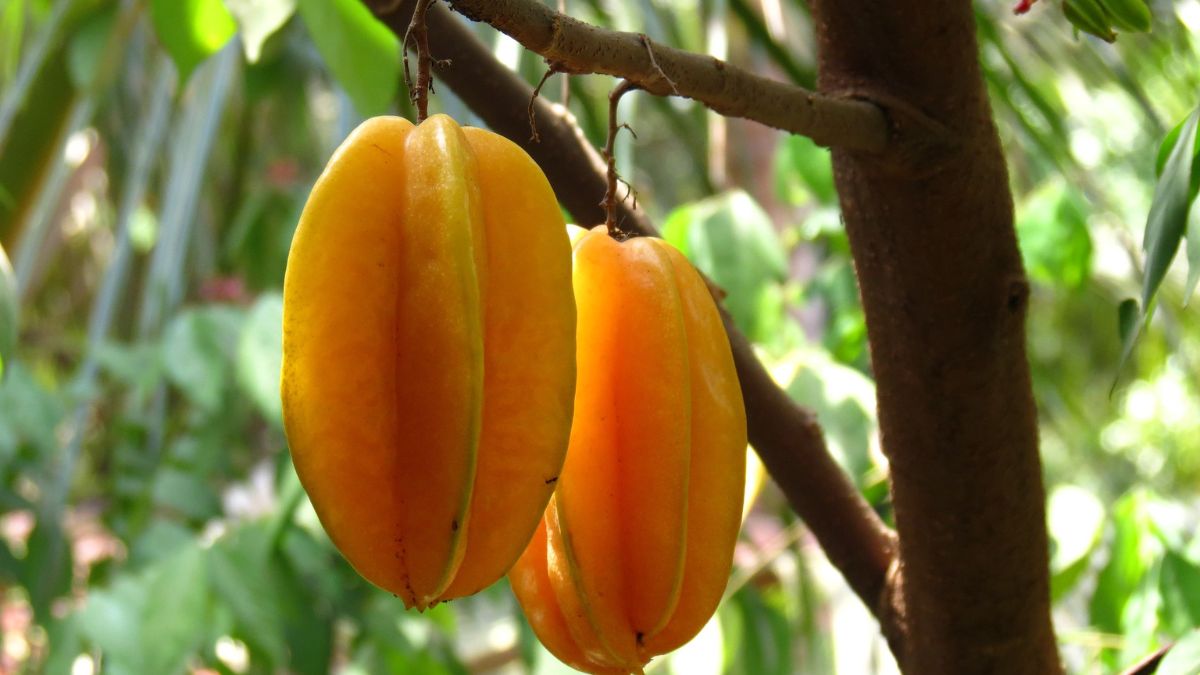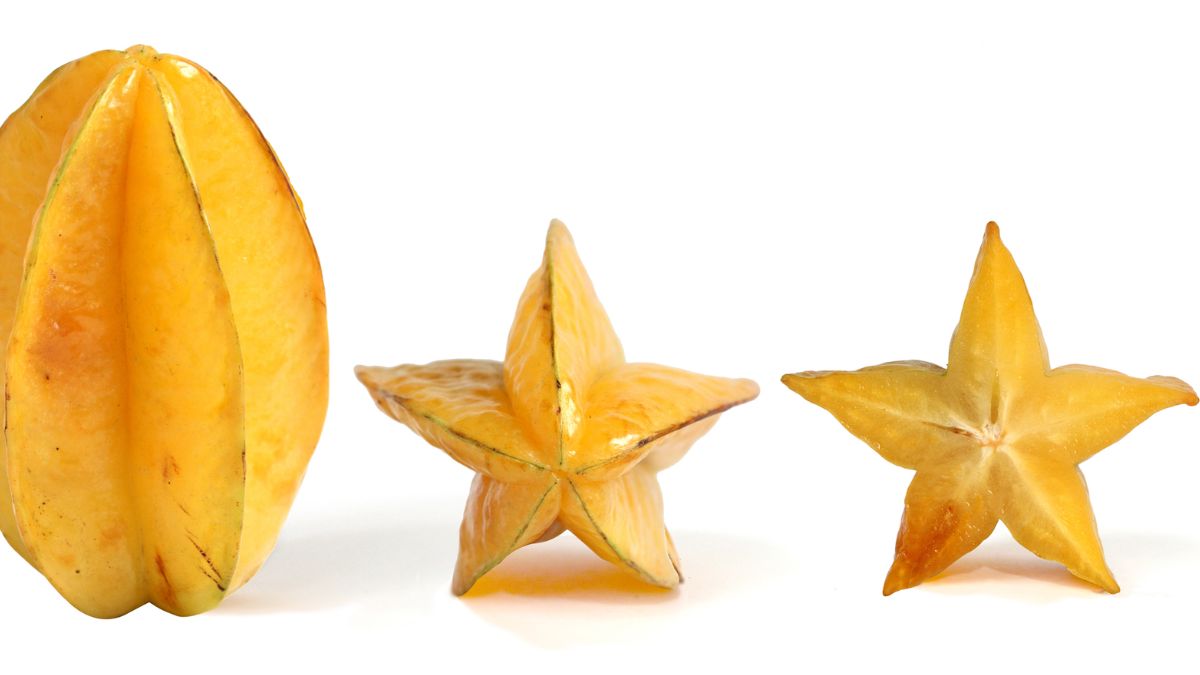The starfruit, also known as carambola, is a tropical fruit found in Asia, the Caribbean, Central and South America, Florida, and Hawaii. There are four to six ribs on its exterior surface, and its color ranges from pale green to golden yellow. The standard length is between 13.7 and 15.2 centimeters or 3-5 inches. Flesh and skin are the same hues, and tiny brown seeds can be found throughout. The fruit derives its name from the fact that it has a star shape when chopped. The star fruit, also known as carambola, is abundant in Southeast Asia and widely grown. This article will show you carambola nutrition facts.
It lends a sweet flavor to various meals, including salads and cocktails, and is widely used as a garnish due to its unique shape. Starfruit is available from late summer to mid-winter. The carambola tree requires less sunshine than most tropical trees to thrive, and the tree requires a lot of moisture and a lot of room. Vitamin C is abundant in starfruit, and it’s a good source of fiber, just as other fruits eaten with the skin on. When selecting a starfruit, aim for a firm and brightly colored one. When ripe, the ribs take on a brown hue. Refrigerate ripe starfruit for up to one week in plastic or use it within a few days at room temperature.
Carambola Nutrition Facts
Here’s a table summarizing the nutrition facts for carambola per 100 grams of edible portion:
| Nutrition Facts | Amount per 100 grams |
| Calories | 31 kcal |
| Carbohydrates | 6.7 g |
| Fiber | 2.8 g |
| Protein | 1 g |
| Fat | 0.3 g |
| Vitamin C | 34.4 mg |
| Vitamin A | 66 IU |
| Folate | 12 mcg |
| Potassium | 133 mg |
| Calcium | 3 mg |
| Iron | 0.1 mg |
Note that these values may vary slightly depending on the specific variety and ripeness of the carambola.
What is Carambola?
The carambola plant is said to be indigenous to Indonesia and thrives in hot, humid environments. It is harvested twice a year, in late fall and spring, but is available all year. The yellow, oval-shaped fruit has ridges and resembles a star when sliced. Depending on the type, it can range in size and color from light yellow-green to bright yellow. The entire star fruit, including the waxy skin, can be eaten, making it simple to prepare and ideal for eating raw or decoration. Star fruit is more expensive than familiar fruits like apples due to its lack of cultivation and appeal in the United States.
What are the Uses of the Carambola?
Because star fruit does not require peeling, it is a convenient snack. Look for star fruit that is bright yellow and a little toasted on the ridges for the sweetest fruit. Green fruit has a slightly acidic flavor, and the maturity you choose is a personal decision. After being selected, unripe fruit will continue to ripen. Choose star fruit devoid of blemishes and brown patches, regardless of ripeness.
By placing the fruit flat on a cutting board, washed fruit can be sliced to show the star shape. Remove both ends with a knife and cut them into slices across the ridges. Remove the seeds with your fingers or a little knife because they are theoretically edible but not appetizing. Star fruit can be eaten raw, added to fruit or vegetable salads, garnished for dishes or cocktails, etc. It’s commonly simmered with sugar and spices like cloves in Southeast Asia or savory meals like fish and shrimp. Unripe or ripe fruit is cooked as a side dish, pickled, or made into a chutney or relish in Australia. You can also dry star fruit.
What are the Benefits of Eating Carambola?
At the same time, star fruit is delicious and healthful. Its sweet and tangy flavor can be guilt-free thanks to its high concentration of health-promoting elements. The following are some of the benefits of eating star fruit.
1. Prevents Inflammation
Vitamin C is abundant in the star fruit. A single serving of this fruit has 57 percent of your daily vitamin C requirements. Vitamin C helps to cleanse your body of impurities, and its anti-inflammatory properties aid in the treatment of skin disorders such as dermatitis. It also aids in the battle against the flu and the common cold. Consuming foods high in vitamin C will help you develop a more muscular immune system and increase your cold resistance.
Vitamin C is also needed by the body to produce collagen, which is present in bones, muscles, and cartilage. It also aids in the absorption of another essential nutrient, iron. Scurvy, terrible skin, slow tissue healing, and exhaustion are all symptoms of vitamin C deficiency. Vitamin C levels will always be ideal if you include star fruit.
2. Good for the Heart
Starfruit is high in minerals, including salt and potassium, which help manage blood pressure. Healthy amounts of these minerals will keep your blood pressure in check and your cardiac rhythm steady. It also contains calcium, which is excellent for your heart.
Calcium in the body in adequate proportions helps reduce the risk of cardiovascular disorders such as strokes and cardiac arrests. It promotes healthy blood circulation and fluid balance in the body, lowering the risk of heart disease.
3. Fights Diabetes and High Cholesterol
100g of star fruit includes 2.8g of fruit fiber, which aids blood sugar regulation. Fruit fiber slows the release of glucose when you consume food. This aids in the regulation of blood sugar and insulin levels.
Fiber-rich foods can help persons with diabetes by preventing it and actively helping those who already have it. Starfruit is a nutritious, guilt-free snack for diabetics and non-diabetics alike because it is easy to eat and high in fiber.
Fibre also aids in the reduction of high cholesterol, which increases the risk of heart disease. Furthermore, this fruit has only 0.3 grams of fat per 100 grams, which is ideal for maintaining good cholesterol levels.
4. Better Digestion and Metabolism
Another health benefit of this fruit’s high dietary fiber content is that it aids digestion, and aids in regulating stool size and softness, making it easier to pass through your system. Constipation sufferers will benefit from this fruit because it stimulates digestion and improves intestinal health. Other symptoms of poor digestion, such as cramps and bloating, will be alleviated by good intestinal health.
Vitamin B is also abundant in the fruit, necessary for good cell activity and development. Riboflavin and folate, often known as folic acid in dietary supplements, are two kinds of Vitamin B found in star fruit. These vitamins help control your metabolism and keep your hormone and enzyme levels in check.
5. Healthy Hair and Skin
Starfruit is high in antioxidants and vitamins B and C, which aid in the mending of skin and hair cells, resulting in lustrous hair and skin. Antioxidants like gallic acid and quercetin, in particular, have potent anti-inflammatory and antihistamine activities.
6. Regulates Weight
The star fruit’s low sugar content makes it a perfect snack for those who don’t want to gain weight. The high fiber content also speeds up your metabolism, allowing you to burn calories more quickly. Fiber-rich foods are also more filling than their low-fiber counterparts, keeping you satisfied for longer.
What is the Flavour of the Carambola?
Star fruit has a sweet, somewhat tangy flavor and a juicy, firm texture similar to grapes. The fruity flavor is hard to explain, but it tastes like ripe pear, green grape, and orange. Unripe fruits are more complex and tarter, with a flavor similar to a green apple. It has an oval shape with five or six points extending from the center. The meat is translucent and tasty, with numerous tiny seeds or “seeds” embedded.
There are two types of star fruit: one with yellow skin and the other with green skin. The yellow-skin variant tastes sweet, while the green-skin variety tastes sour. The juicy, acidic flesh of the star-shaped fruit tastes similar to citrus fruits like oranges and lemons. Some people compare the flavor to grapefruit or pineapple. It’s edible raw or cooked, although it’s not a particularly filling fruit.
Star fruits are eaten raw or cooked in salads and desserts, such as an apple pie with whipped cream. It can also be used for drinks like green smoothies made with blended starfruit and other ingredients like milk or yogurt. This plant’s leaves have been shown to have therapeutic properties because they contain compounds that inhibit the growth of germs connected to stomach ulcers. To prepare sweets with starfruit, substitute it for pineapple in any recipe.
Where can I Get Carambola?
Star fruit is commonly available all year in the produce section of supermarkets, and it’s typically offered per pound or in three- or four-pound packages. Visit an Asian market if your local market does not have star fruit. The fruit is prevalent in Southeast Asia and may frequently be seen in specialty markets. Commercial star fruit is grown in the southern United States and can be found in Florida, Texas, and California farmers’ markets. Look for brilliant yellow or yellow-green star fruit that is weighty for its size and firm but not hard. The ridges turn light brown when the fruit is ripe. In warm climates, star fruit can be cultivated at home. The little trees thrive in pots and can be brought indoors to escape frost during the winter.
How to Store Carambola?
Store star fruit at room temperature, away from direct sunlight. Star fruit will keep for a few days depending on maturity. To protect the fruit from becoming overripe, store it in the fridge for up to four days once the ridges have gone from green to light brown. Overripe fruit will have brown spots all over it and a rotten flavor. Star fruit puree or juice can be kept in the fridge for a few days or frozen in an airtight container for three months.
How to Eat Carambola?
Ripe star fruit has the most excellent flavor. Unripe star fruits can have a sour, even bitter flavor.
Allow a green-ribbed star fruit to mature until it becomes yellow before eating it. Keep the fruit at room temperature, turning it occasionally until it develops a fragrant “perfume.” You’re searching for a solid floral-fruity aroma, suggesting the fruit is at its peak. If you plan on serving the fruit within a day or two, you can keep it at room temperature. If not, keep the ripe fruit refrigerated to extend its shelf life.
You can prepare star fruit by simply doing the following:
- Cleaning it with water
- Cutting off the edges
- Not peeling the skin
- Slicing it horizontally
Try combining the fruit with avocados, kiwis, mangoes, and bananas in a fruit salad or puree. To make an edible garnish, sauté star fruit slices for a few seconds and then glaze with sugar. Serve this with fish and poultry, or use it to garnish cold beverages instead of lemon or lime slices.
Conclusion
You’ve probably already tried superfoods like mushrooms, blueberries, lentils, kale, and other green leafy vegetables, which pack a powerful punch of vitamins, minerals, antioxidants, and other nutrients while low in calories. Star fruit, also known as ‘Kamrath’ in Hindi, is one such superfood. Fill each well halfway with carambola juice, allowing 12-inch headspace. Freeze for 24 hours. Once frozen, flip the mold or ice cube tray onto a plate or cookie sheet, and the liquid will melt and slip from the mold after a few minutes. Allergies. Although star fruit allergy is relatively uncommon, certain people should avoid it. Stay away from star fruit if you feel unpleasant reactions like nausea, diarrhea, or even vomiting after eating it.

